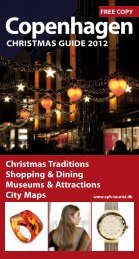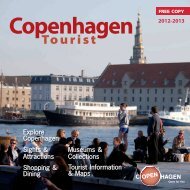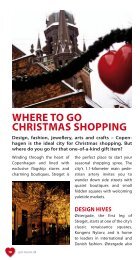eat style oughout enturies - Copenhagen Tourist
eat style oughout enturies - Copenhagen Tourist
eat style oughout enturies - Copenhagen Tourist
You also want an ePaper? Increase the reach of your titles
YUMPU automatically turns print PDFs into web optimized ePapers that Google loves.
y some of Denmark’s most celebrated<br />
artists. In the gr<strong>eat</strong> hall you’ll find the<br />
Queen’s tapestries from 2000, which may<br />
well be Denmark’s most monumental<br />
twentieth-century artwork. The 17 tapestries<br />
were designed by Danish artist Bjørn<br />
nørgaard and woven in paris. his sketches for<br />
these tapestries are on display at the KØS<br />
Museum for art in public Spaces in Køge, just<br />
south of <strong>Copenhagen</strong> (see page 102).<br />
The Royal Reception Rooms are open to the<br />
public when not used for official purposes.<br />
The Ruins of AbsAlon’s CAsTle<br />
– RuineRne Af AbsAlons boRg<br />
archbishop absalon, the official founder<br />
of <strong>Copenhagen</strong>, built the city’s first castle,<br />
which was completed in 1167. The castle<br />
ruins can be visited in the basement of<br />
Christiansborg palace, where you’ll also<br />
find a historical exhibition of all the five<br />
edifices that have occupied the site on<br />
Slotsholmen.<br />
The DAnish pARliAmenT<br />
– folkeTingeT<br />
Christiansborg palace is the s<strong>eat</strong> of the Danish<br />
parliament where 179 elected members<br />
from across the kingdom meet to debate<br />
and adopt the laws by which Denmark is<br />
governed. The Danish parliament occupies<br />
most of the palace, comprising more than<br />
44,000 sq. metres and 750 rooms. In recent<br />
years, the Danish parliament has expanded<br />
to include most of King Christian IV’s old<br />
storage rooms.<br />
To help members conduct their day-today<br />
legislative work, all political groups have<br />
their own secretariats. In addition, many<br />
journalists have offices at Christiansborg,<br />
too. During busy periods, more than 1,000<br />
people work at the Danish parliament.<br />
From 2 July-3 august when the parliament<br />
is in recess, daily guided tours are offered<br />
in english at 13:00. From 6/8 - 14/9 daily<br />
guided tours in english at 13:00. The rest of<br />
the year guided tours in english are offered<br />
every Sunday at 13:00. www.ft.dk<br />
Folketinget (the Danish parliament) is the nation’s<br />
legislative s<strong>eat</strong>, where 179 elected members debate<br />
and adopt the laws that govern Denmark.<br />
ChRisTiAnsboRg pAlACe ChApel<br />
– ChRisTiAnsboRg sloTskiRke<br />
Christiansborg palace Chapel, located to<br />
the west of the palace, is the private church<br />
of the royal family, used for baptisms,<br />
weddings and other religious ceremonies.<br />
here deceased Danish monarchs lie in state<br />
before they are taken to their final resting<br />
place at Roskilde Cathedral. The chapel<br />
was designed in neoclassical <strong>style</strong> by<br />
architect C. F. hansen (1756-1845) as part of<br />
his commission for the second Christians -<br />
borg palace. although severe ly damaged<br />
by fire in 1992, the chapel has been restored<br />
to its original glory when first consecrated<br />
on 14 May 1826 in celebration of the<br />
millennium of the introduction of Christianity<br />
to Denmark.<br />
Christiansborg Palace Chapel – the church of the<br />
royal family.<br />
cph-tourist.dk<br />
<strong>Copenhagen</strong> 37






